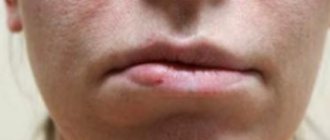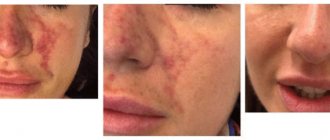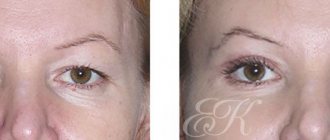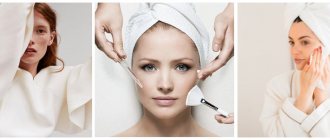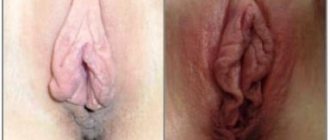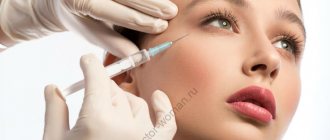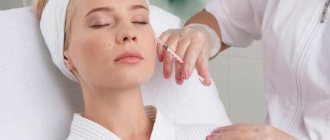What are fillers?
It would seem that there is nothing to talk about here, but no, the question is still relevant. Filler is a mechanical filler that performs a number of tasks when injected into soft tissue at different depths. It can strengthen the skin, redistribute light and shade, masking imperfections, fill wrinkles, lifting their bottom and reducing visible manifestations.
Today, fillers are more often used to add volume to soft tissues, eliminate lip asymmetry, and correct the shape of the nose - they can be used to lift the tip or, for example, remove a hump, or compensate for the lack of chin volume if a person is not ready to go to an orthodontist.
In fact, they have three tasks: to change the quality of the skin, the depth of unwanted relief (wrinkles, folds), and the proportions of the face.
Less is more
Doctors always prefer minimal doses of fillers. You can evaluate the result a couple of days after the procedure, when the swelling subsides and the filler is securely in place.
If the result seems insufficient, you can always introduce an additional dose of gel. This approach allows you to avoid excessive correction, which looks artificial and even ridiculous.
The dosages given in the article are nothing more than a guideline for thoughtful patients who want to get to the bottom of the procedure. The final choice of filler, its quantity and method of administration should always be made by a doctor. This is possible only after examination and must take into account all the individual characteristics of the patient.
What types of fillers are there?
They can be divided into two large groups: hyaluronic and fillers made from chemical substances that have no analogues in the body (calcium hydroxyapatite - Radiesse, silicone - practically not used today, polylactic acid and others).
The most universal groups of fillers are hyaluronic. 99% of aesthetic problems in our and the world market are solved by them.
And it's easy to explain. HA (hyaluronic acid) is built from a repeating disaccharide sequence. Remember the snake in Tetris? HA is approximately the same chain, capable of growing and adding new links.
The structure of hyaluronic acid is the same in everyone: in humans, in bacteria, and in animals. No matter how HA is synthesized, it will not be foreign to our body and will not cause a specific immune response. In simple terms, the introduced substance is “on board” - you don’t have to worry about allergic reactions. This is why hyaluronic fillers have become so popular.
Biosynthetic
This long-acting drug began to be developed back in the 90s. For production, high-quality chemical modification of the components was used. They are of biological origin.
The main manufacturers of this product:
- "Artekoll" is a high-quality product that contains soluble callogen based on polymethyl methacrylate. After a certain time, the connective tissue resumes its action of encapsulating the smallest insoluble gel particles. Therefore, with its use, an effective corrective result is achieved. Biosynthetic injections are used to eliminate wrinkles, defects of body parts and lip correction;
- "Radiesse" is a drug based on calcium hydroxyapatite. This is a specific suspension of hydroxyapatite particles, which is located in a buffered polysaccharide gel. The effect of the drug is ensured by the synthesis of collagen by fibroblasts;
- "Elance" is a product based on polycaprolactone. The soluble gel particle in the preparation is carboxymethylcellulose. The main effect of the gel is based on stimulation of the neocollagenesis component. Due to the action of this component, tissue volume increases.
What are the consequences of taking fillers too early?
Injecting fillers is not the prevention of wrinkles! They leave behind "traces". If you get too carried away with fillers at age 20, after 5-7 years you can get irreversible changes in soft tissues, leading to swelling, changes in skin density and uniformity. You can't win it back!
Those who, from the age of 20, begin to maintain volumes in the hypertrophied, fashionable version today - high cheekbones, elongated chin, large lips, after 5 years can develop a number of problems that cannot be solved without surgical intervention.
At a minimum, the person will appear older due to loss of tissue uniformity. In facial expressions, such girls look like well-made, “tuned” women. With these smooth transitions and perfect lines, charm and youth are lost. So fillers are not so harmless.
Indications
Why this technique will have the most positive effect:
- formation of age-related, facial wrinkles and depressions;
- lack of natural volume, firmness, smoothness and elasticity of the skin;
- looseness of the skin of the face, neck, décolleté;
- the need for correction of any areas of the face. Popular use of lip enhancement gels. Materials are also used to correct the chin, sunken cheeks, nose shape, earlobes, eliminate wrinkles in the space between the eyebrows, etc.;
- the need to eliminate dermatological problems - stretch marks, acne marks, acne, etc.
When are fillers useless?
When masking a hernia in the lower eyelid, for example, you need to understand that this area often swells. It can be corrected even from the age of 20, but the result of these procedures will still be a visit to the surgeon. I think that in this case this option is rational, especially since modern techniques make it possible to remove hernias without incisions and a long rehabilitation period. The longer you wait, the more complex the operation with the removal of a skin flap and other side effects will be.
We can correct this cosmetic defect with fillers, but sooner or later we will get tissue changes that will cause swelling! The solution to this problem lies beyond the competence of a cosmetologist. I always warn patients about this. As they say, cosmetologists’ best friends are surgeons (laughs).
Lipofilling
This technique allows you to correct the patient’s fat tissue.
The activity of using lipofilling is the elimination of minor skin defects, correction of undesirable areas: hands, buttocks, waist, and so on.
At what age can fillers be used?
It all depends on the zone. If, for example, a person has an unpronounced hump on his nose that he doesn’t like, he can correct it with filler even at 18! What's the point of waiting and collecting complexes when the problem is solved with 0.1-0.2 ml of the drug? In this area, tissue changes are only to our advantage: after several professional corrections, we will achieve a result that will last for a long time.
It's the same story with the chin. When a person has an insufficiently pronounced or slanted jaw, there are several options for solving the problem: orthodontics, surgical advancement of the lower jaw with a long rehabilitation period, or correction with filler. In this zone you don’t have to worry about swelling – maintain the results for at least 20 years without fear of consequences.
The story with lips is more complicated. With repeated corrections and failure to comply with the decay time of the filler from the previous injection, we can get a change in blood circulation with the formation of stagnation - edema.
Follow the time limits and be careful! I am not against the introduction of gel if a person has asymmetry, disproportion or a pronounced defect - everyone wants to be beautiful here and now. “Let’s do it because it’s fashionable” is not my story.
Cheekbone correction
Facial contouring is not always due to the fight against aging. Using hyaluronic acid fillers, you can correct your cheekbones to give them the desired shape and volume. This procedure is also a prevention of dynamic sagging of soft tissues, which occurs with age.
The procedure for introducing fillers into the cheekbones is carried out according to a pre-selected scheme. The doctor makes markings and marks the injection sites. If you just need to add a little volume, then there will be two or three injection points for the drug on each side: at the temple and in the middle part of the face. The doctor injects the drug vectorially, precisely following the intended lines and controlling the depth of filler injection. This technique allows you to create a lifting effect and correct the shape of your cheekbones.
The number of drug injection points and their location depend on the intended goals and the condition of the patient’s face. The exact scheme for performing contour plastic surgery is drawn up by a specialist after examining the client and having a preliminary conversation.
What do fillers break down into and how are they removed?
The method of removing filler is universal - our body applies it to all foreign bodies. A little background to make it clearer.
When a foreign body enters the body through an injury, one does not need to be a rocket scientist to understand that it is not welcome. His primary task is to determine how harmful the “guest” is. And then there are three options for the development of events.
First. If the substance can be destroyed, the body will do so, happily forgetting about it after a few days.
Second. If the foreign body cannot be destroyed, the body “assesses” the degree of danger to surrounding tissues. Everyone has driven a splinter at least once in their life. Remember what happens a few days later? The body destroys neighboring tissues, creating a purulent mass, and along with it removes the “uninvited guest”. Some groups of non-hyaluronic fillers break down along this path. The following situation often happens to them. They lie quietly for 2-3 years - the body does not touch the inert substance, which does not pose any danger to it. Over time, fragments break off from them, irritating the tissue.
The body says: “Friend, you’re not cool, you didn’t interfere with tissues before, but now you’re making tricks. I’d rather cause inflammation, destroy the surrounding tissue and try to expel you.”
After several years, low-quality fillers can migrate, become inflamed and lead to other complications.
Third. After the filler is introduced, the body “understands” that it is not toxic, not dangerous, but it was introduced through an injury and this substance cannot be immediately destroyed. It begins to surround the foreign body with a capsule, which is completely formed after 3-4 weeks. It is done! The isolated substance lies quietly in the capsule until the body destroys it - this is what happens with hyaluronic acid. Normally, after a year it breaks down into CO2 and water. For some time, fragments of the capsule still remain in the lips, but they will normally be disposed of over time.
What are they used for?
Thanks to anti-aging products, you can get rid of nasolabial linings and tear troughs. It is even used for a facelift after 50 years.
With the help of the drug you can:
- form the correct relief and make the skin smooth;
- remove skin changes that appear with age;
- prevent premature aging;
- makes the skin smooth, elastic and elastic. Prevents premature wilting;
- corrects areas of the face - lips, cheeks, nose, cheekbones, eyebrows. As well as between the eyebrows, eyelids and chin. A popular procedure is the injection of gel under the eyes; it allows you to fill wrinkles of varying depths;
- creates the correct contours, oval and facelift;
- allows you to get rid of tear troughs or the effect of tired eyes.
Do hematomas always remain after filler injection?
It all depends on the anatomy. There are areas with a rich blood supply - the lips. When a needle is used in this area, hematomas will occur with an 80% probability. The question is how big they will be.
In the zygomatic area, specialists use an atraumatic cannula. After it, bruises are the exception rather than the rule - the likelihood of hitting a vessel is low.
Cosmetologists are not x-rays. No professional can say with 100% certainty that it will not fall into the vessel.
Prices
Price depends on brand and quantity:
- Correction of nasolabial folds, which requires approximately (1 ml) of Restylane, will cost you from 15,000 to 20,000 rubles .
- The cost for such a service from the Surzhiderm filler brand (0.8 ml) can range from 12,000 to 17,000 rubles .
- Correction of shallow folds with Belotero Soft (1 ml) will cost from 13,500 to 145,000 rubles . But larger-scale work with the same drug reaches a minimum cost of 19,000 rubles .
- For 1 ml of gel from Ivor it will cost from 9,000 to 15,000 rubles.
- For 1 ml of the Juvederm brand you will have to pay from 15,000 - 22,000 rubles .
Do you want to know what the first signs of sinusitis in adults are and how to treat it at home? Then we recommend reading the article. What are the reasons for the appearance of iron taste in the mouth of women during pregnancy, you can read here.
You can read about how to enlarge your lips at home using nicotinic acid in our article.
Is it possible to feel the filler?
In the cheekbone area - no. There the drug is injected very deeply. Even if you press intensely, you are unlikely to feel anything. I'm talking about the norm, and not when 5 ml of filler is injected into the cheekbone area.
When gently introduced into the lips, the drug is also not felt. If you overdo it, you can feel the seals when pressing. Normally this is not noticeable!
When a girl had thin lips, and she “swelled” them to enormous sizes, this will most likely be noticeable during a kiss - I don’t have such experience, but for scientific purposes you can experiment (laughs).
Contraindications
The list of contraindications is quite long:
- diabetes;
- pathologies in the functioning of the body associated with blood clotting disorders;
- diseases such as HIV, cancer, syphilis, hepatitis B and C, etc.
- allergic reactions to components contained in the filler;
- pregnancy and lactation;
- menstruation at the time of insertion;
- inflammatory formations at the injection site;
- during the period of exacerbation of chronic ailments, when the body is infected. After completing the course of therapy, you can begin the specified correction.
- recovery period for cosmetic procedures;
- presence of silicone in the area being treated.
Complete aesthetics in dentistry
This article will clearly demonstrate how the correct choice of dental technologies, materials and injectables affect overall esthetics in terms of function, smile line, lip contour and phonetics. You will see that only a complete intra- and extra-oral solution to maxillofacial problems is considered truly aesthetic dentistry, and with the right training can become a tool for any dentist.
Clinical case
Several years ago, the patient had two all-ceramic crowns fixed on her two upper incisors. In addition, veneers were made on the upper and lower teeth (Photo 1). One day, the patient noticed that the left upper central incisor (tooth No. 9) had become somewhat mobile, and she went to the clinic with these complaints. Upon palpation, tooth mobility turned out to be real. After an X-ray examination, it became clear that the patient had a horizontal tooth fracture (Photo 2). This tooth clearly could not be restored, so it was removed and an implant was installed in its place (Photo 3). A Procera crown (Nobel Biocare) was fixed to the implant, and the patient was completely satisfied with the stability of the new tooth. What she was not satisfied with was the lack of interdental papilla, known as “black triangles” (Figure 4). This is one of the most unpleasant aesthetic complications that can arise when placing implants, fixing bridges and crowns. An innovative solution developed by the author of the article and the American Academy of Facial Aesthetics is the use of dermal fillers (Juvederm Ultra XC) to replenish the volume of the interdental papilla and eliminate black triangles (Photo 5).
Photo 1: The patient presented with a mobile crown on the upper central left incisor.
Figure 2: A horizontal fracture is evident on x-ray.
Photo 3: The implant was placed using standard techniques.
Photo 4: Insufficient volume of interdental papillae (black triangles) as a result of implantation.
Photo 5: Use of dermal fillers to restore the volume of interdental papillae and eliminate black triangles.
One thing clings to another
After the treatment, the patient became interested in having her crowns and veneers redone. Her complaint is clear from Photo 6. The new crown on the upper left central incisor was slightly darker than the rest of her teeth, and when she smiled widely, it did not show as much teeth as she would have liked. The patient also wanted a lighter shade of her teeth, and the lower veneers were slightly chipped during wear over the past few years (Photo 7), in addition, the veneers detached several times, the fixation of which had to be repeated from time to time. She stated, “my bottom teeth look short and worn out.” In addition, the patient had a very deep bite (photo 8).
Photo 6: Smile is limited due to facial aging.
Photo 7: Upon closer inspection, there are noticeable chips in the existing veneers, which are made from low-strength ceramic.
Photo 8: The patient has a deep bite.
I, like any other doctor with sufficient experience in facial and dental aesthetics, can provide new perspective and options that can be applied to similar cases and show how facial parameters can become part of planning and treatment in aesthetic dentistry. Everything I mean is demonstrated quite clearly in Photo 6. Look at this patient as she smiles widely. The buccal corridors in the premolar area are hidden, thereby hiding the full smile. Since dentists mainly focus only on the teeth, most specialists would choose to make crowns on the premolars and thereby fill the buccal corridor. For this patient, there is no dental solution that would significantly improve the esthetics due to the loss of midfacial volume. Adding volume to the middle of the face will correct the aesthetic relationship of her upper lip and teeth. In a full smile, the edge of the patient's upper lip should slightly expose the necks of the upper central incisors. This will be the treatment plan, including restoration of teeth and correction of soft tissues.
When time is under control
It happens to all of us. People usually begin to lose skin collagen and facial fat around age 40, with the process accelerating after age 50. This causes wrinkles to form around the mouth and in the maxillofacial area. The patient in question is a good example of this, and clinically the aging of her face is manifested by less exposure of the upper teeth and more of the lower teeth. Due to this natural process, the woman does not have the high level of cheekbones that she previously had, and also has very deep nasolabial folds, all of which is complemented by insufficient support for the upper lip, so some teeth are hidden, especially in the lateral segments of the jaw. This problem cannot be resolved by simply restoring teeth. In this situation, Botox and dermal fillers are needed in addition to veneers.
Photo 9 shows the results of using Botox and dermal fillers to correct muscle activity and volume in the middle of the face. Her cheekbone area now has good support and added volume. The patient now demonstrates an aesthetic smile and lip line with function as described above. Her nasolabial folds have decreased and her upper lip has enough support for a wide smile. In situations like this, it is very important to have a carefully designed treatment plan that coordinates all efforts to restore soft tissue and teeth.
Photo 9: After soft tissue correction with dermal fillers, the patient shows a much wider smile.
A total of 2.4 mL of calcium hydroxylapatite dermal filler (Radiesse) was injected into the left and right malar areas, resulting in support of the nasolabial folds and upper lip. The nasolabial folds were filled with 1.9 ml of hyaluronic acid dermal filler (Juvederm Ultra XC).
Facial changes lead to smile changes
The veneers can now be replaced to complete the aesthetic treatment. The patient now smiles much wider and is ready to have new structures installed. One of the problematic issues: the upper left central incisor has a higher gum level than the right incisor due to the placement of the implant (Photo 10). This problem was also included in the treatment plan. The treatment plan includes the production of 10 new veneers for the upper jaw and 10 for the lower jaw. The upper central incisors, however, also form a problem. Cutting off the part of the Procera crown that is fixed to the implant is not a good idea. With such an operation, there is a high probability of causing major damage to the implant abutment, and this is not the wisest decision. In this situation, it was decided to fix ceramic veneers to the existing crowns of the upper central incisors without attempting to remove them. The system chosen is called Cristal Veneers (Aurum Ceramics), which represents the latest generation of non-minimally invasive veneers with structures that can be manufactured as thin as 0.3 mm, yet are both durable and esthetically pleasing. Cristal Veneers can also be made in the same thickness as any other veneers.
Photo 10: The central incisors have insufficient gingival margin height.
All previously fixed veneers were removed and minimally invasive preparation was performed. In this case, each veneer will be manufactured with an individual thickness. Photo 11 shows the preparation guide (Aurum Ceramics) and the absolute minimum preparation of the crowns of the two upper incisors, so that the thickness of the veneers for them reaches no more than 0.3 mm, while the thickness of the veneers for the lethal incisors will already be from 2.5 to 3 mm . All other veneers are also made to a custom thickness, which is also important for minimally prepared lower teeth (Photo 12).
Photo 11: A preparation guide was applied to ensure minimal yet complete intervention.
Photo 12: Minimal preparation of veneers on the lower jaw.
During the preparation visit, the gingival margin was corrected. A hard and soft tissue laser (WaterLase iPlus BIOLASE) is used on the upper right central incisor to perform not only gingivotomy but also sulcus lengthening to achieve a single level. This operation is easily carried out with sufficient technical equipment and experience. Due to the predictability of this procedure, we could evaluate the results obtained on the day of the operation. You can look at the prepared teeth and the corrected gum in photo 13. Due to the surgical aspect of the treatment, it was especially important to fix the temporary structures and wait for the gums to fully recover. The material chosen for temporary structures is Dentocrown (Itena USA), it has stability, excellent adaptation to the gum and self-polishing, which helps preserve the gingival margin (Photo 14). Temporary structures were perfectly preserved during the entire time required for the production of veneers.
Photo 13: Preparation for veneers and precise laser correction of the gingival sulcus to correct the gingival margin (WaterLase iPlus BIOLASE).
Photo 14: Temporary veneers made of a unique material (Dentocrown Itena USA).
Now the biggest difficulty
The veneers are made and returned from the laboratory, now the biggest challenge begins. The temporary structures were removed under local anesthesia. Laser gum correction was carried out successfully, as evidenced by complete tissue healing (Photo 15).
Photo 15: Excellent gum healing visible after removal of temporary restorations.
Fixation of veneers in this clinical case had several difficult moments. The first challenge is effectively etching and bonding a wide variety of surfaces such as enamel, dentin, cementum and porcelain. Photo 16 shows phosphoric acid etching of enamel, dentin and cementum, as well as 4% phosphoric acid etching of Porcelain Etch (Ultradent Products) on all porcelain surfaces. The effectiveness of etching materials can be seen in photo 17. Silane is applied and distributed on the surface of the veneers, as is Iperbond Ultra (Itena USA) - a universal bonding agent of the latest generation that forms a reliable adhesive layer for many surfaces, including the surfaces of hard dental tissues, ceramics, zirconium and other materials.
Photo 16: Etching techniques for different surfaces.
Photo 17: High-quality etching looks like a “frosty” surface of the teeth.
Anyone who has bonded veneers of varying thickness has had difficulty matching the final color. Fixing veneers is a very lengthy procedure, during which the dentist tries to use cements of various shades. Personally, it seems to me that this problem should be solved not by a doctor, but by a laboratory; it is the technicians who know better the shades and materials they work with.
The color of the veneers was 020, and cement of the appropriate shade was chosen for fixation. I used light-curing cement for porcelain veneers (Nexus 3 Kerr) because of its ease of use, color stability, and excellent texture, suitable for cementing any type of veneer, both thick and thin. Photo 18 shows fixed veneers in the mouth. The gingival margin of the left upper central incisor exactly coincides with the gingival margin of the right one. Please note that the thickness of the veneers on the central incisors is about 0.3 mm, while the others are from 1 to 3.5 mm, but they all show an absolutely identical shade. For fixation, it was enough to use cement of only one shade. The lower veneers now maintain the required facial height.
Photo 18: Final appearance of Cristal Veneers (Aurum Ceramics). Note the gingival margin above the central incisors.
Bonding veneers to a ceramic crown involves the use of a number of agents in a specific sequence.
Photo 19 shows the final appearance of the happy patient. The final result was achieved through a complex of dental therapy and aesthetic procedures. What is interesting in this case is the ease of performing these injections with proper training.
Photo 19: Complete dental and facial aesthetics achieved with veneers, Botox and dermal fillers.
Final comment
This article clearly demonstrates that aesthetic dentistry is not limited only to manipulations in the oral cavity. True and complete aesthetics is a combination of work on the teeth and the entire facial area as a whole.
Author: Louis Malcmacher , DDS, president of the American Academy of Facial Esthetics
